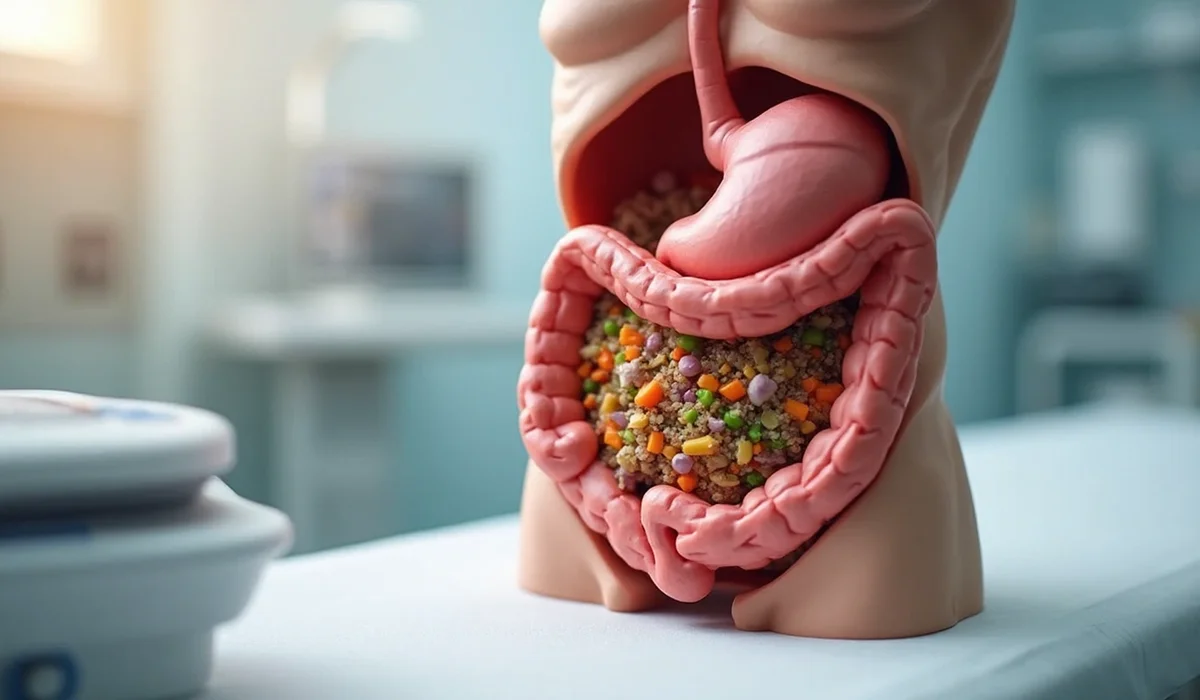Gastroparesis disrupts digestion in about 4% of people, and women get it much more often than men. The numbers tell an interesting story – among every 100,000 people, only 10 men develop this condition compared to 40 women. The data shows that many gastroparesis patients already have diabetes, with about half of them having diabetes before their digestive issues started.
Let me explain what gastroparesis actually is. Food stays in the stomach too long because it doesn’t empty properly – doctors call this delayed gastric emptying. This happens because stomach muscles don’t contract the way they should, so food and drinks can’t move through the digestive system normally. The biggest problem usually comes from damage to the vagus nerve that controls stomach muscles. The tricky part is that gastroparesis looks like other digestive problems, which makes it hard to figure out why it happens.
This piece covers everything about slow digestion, from how it works to treatment options. You’ll learn why diabetes patients, especially those with type 1, face higher risks. We’ll also get into how this condition can lead to serious health issues like dehydration and malnutrition. The information here helps both newly diagnosed patients and those looking for better ways to handle this complex condition that affects thousands of Americans each year.
What is Gastroparesis?
The digestive process begins in your stomach – a remarkable muscular organ. This muscular sac can hold up to a gallon of food or liquid. Your stomach works as both a storage container and processing plant for everything you eat.
How the stomach normally empties
Your stomach processes food through a precise sequence of muscular activities under normal conditions. The fundus (upper portion) relaxes to make room for incoming food—a process called accommodation. Your stomach’s muscular walls then contract. These contractions create peristaltic waves that grind food into smaller pieces and move them toward the exit.
Your stomach takes about 1 to 1½ hours to break down food into smaller particles and push them through the digestive tract. The stomach’s body acts as a reservoir for mixing food and serves as its pacemaker. The antrum (lower portion) grinds food into tiny 1-2 mm particles through repeated contractions – a process called trituration.
The pyloric valve connects your stomach to your small intestine. Once food particles reach the right size, this valve relaxes to let them pass into the duodenum. Here, further digestion and nutrient absorption take place. Liquids move through faster than solids, and smaller particles pass more quickly than larger ones.
What happens in gastroparesis
Gastroparesis disrupts this well-coordinated process. The term means “stomach paralysis,” but Dr. Gluckman points out that this name isn’t quite right. The stomach isn’t completely paralyzed—it just moves food more slowly.
The stomach muscles work poorly or stop working during gastroparesis. The biggest problems include weak antral contractions and poor pyloric relaxation. Gastroparesis specifically involves:
- Weak muscle contractions that can’t properly mix food
- Poor coordination between stomach sections
- The stomach struggles to push food into the small intestine
- Food stays in the stomach too long
Food that stays too long in the stomach can cause several problems. Old food sometimes forms a solid mass called a bezoar. These masses can block the stomach and make symptoms worse. They might even stop food from reaching the small intestine.
Why it’s called ‘delayed gastric emptying’
Doctors use “gastroparesis” and “delayed gastric emptying” to mean the same thing. The term delayed gastric emptying describes what actually happens – food takes too long to leave the stomach.
Doctors diagnose delayed gastric emptying through a special nuclear imaging test called gastric emptying scintigraphy. The test shows more than 60% of a meal still in the stomach after 2 hours or more than 10% after 4 hours. This test adds a radioactive tracer to a standard meal and tracks it through your digestive system.
Whatever you call it, the biggest problem stays the same – food sits in your stomach too long and disrupts digestion. This delayed emptying leads to nausea, vomiting, bloating, stomach pain, and feeling full quickly after eating. It can also affect blood sugar control, nutrient absorption, and how well medications work.
What Really Causes Gastroparesis?
The mechanisms behind gastroparesis help explain why treatments differ so much between patients. The symptoms may look similar, but what causes them can vary substantially from person to person.
Diabetes and nerve damage
Diabetes remains the most common known cause of gastroparesis. Research shows that about 5% of people with type 1 diabetes and 1% with type 2 diabetes develop this condition over 10 years. The condition develops as high blood sugar damages the vagus nerve that controls stomach muscles. Blood glucose levels above 200 mg/dL can harm these nerves, leading to diabetic neuropathy.
The nerve damage affects both the autonomic nervous system and special stomach wall cells called interstitial cells of Cajal. Better blood sugar control can’t reverse the damage once it happens. People who have diabetes-related issues like retinopathy or nephropathy also face higher risks of developing gastroparesis.
Medications that slow digestion
Many medications can either cause gastroparesis or make existing symptoms worse. Here are the main ones to watch for:
- Opioid pain relievers that substantially slow down stomach emptying
- Anticholinergic medications such as diphenhydramine and tricyclic antidepressants
- GLP-1 agonists used to treat diabetes (like exenatide and liraglutide)
- Calcium channel blockers prescribed for high blood pressure
- Certain allergy medications
Doctors carefully review their patients’ medication lists when checking for gastroparesis symptoms.
Post-surgical complications
Upper abdominal surgeries can sometimes damage the vagus nerve accidentally. This leads to postsurgical gastroparesis syndrome (PGS), where food moves too slowly through the stomach without any physical blockage. Surgeries like fundoplication, gastrectomy, pancreatectomy, and vagotomy often link to this issue. PGS affects 0.4-5.0% of patients after gastrectomy and 20-50% after pylorus-preserving pancreatoduodenectomy.
Viral and autoimmune triggers
A newer study, published in 2021 by researchers found that viral infections might trigger gastroparesis. The list includes cytomegalovirus, Epstein-Barr, norovirus, and herpes varicella-zoster. Research shows that 19% of patients with unexplained gastroparesis remembered having an infection before their symptoms started.
The autoimmune connection has become an exciting area of research. Scientists have found several antibodies that might attack stomach nerves, including GAD antibodies (common in type 1 diabetes) and calcium channel antibodies. Some cases we used to call “unexplained” might actually stem from autoimmune responses.
Neurological and muscular disorders
Many neurological conditions relate to higher gastroparesis risk. Parkinson’s disease patients develop the condition in part because α-synuclein protein builds up in their digestive nervous system. Multiple sclerosis, cerebral palsy, and autonomic disorders can disrupt nerve signals to stomach muscles. Connective tissue diseases like scleroderma and amyloidosis can also directly damage stomach muscles.
Idiopathic cases: when the cause is unknown
Doctors can’t pinpoint the exact cause in about 25-50% of gastroparesis cases, which they label as “idiopathic”. These cases remain the most puzzling, though research hints at possible undiagnosed autoimmune factors. Young women between 17-35 make up most of these unexplained cases, which suggests possible hormonal or genetic factors we haven’t found yet.
Common Symptoms in Adults
People with gastroparesis deal with uncomfortable symptoms that vary from person to person. These symptoms don’t just come and go like regular digestive problems. They stick around and affect daily life by a lot.
Feeling full quickly or for too long
Many gastroparesis patients feel unusually full after eating small amounts of food. Studies show this affects 50% of patients severely. This quick fullness makes them leave meals unfinished. The feeling of being too full after eating hits even more patients, with 60% reporting severe cases.
The fullness just doesn’t go away like it should. Patients tell me they eat dinner and still feel stuffed the next morning. They can’t even think about breakfast. Food stays in their stomach much longer than normal, causing this lasting fullness.
Nausea and vomiting
Nausea ranks as the most common gastroparesis symptom. It affects 96% of patients. Many consider it their worst symptom, with 41% rating their nausea as severe. The queasiness usually comes with meals – 71% of patients report this connection.
Fewer patients experience vomiting, but it still affects 65% of them. The pattern changes based on the type of gastroparesis. Diabetic patients (81%) throw up more often than those with idiopathic gastroparesis (57%). Diabetic patients also tend to vomit more in the morning before eating and at night.
Bloating and abdominal pain
Stomach pain comes from both motor and sensory nerve problems. When stomach muscles don’t work right, trapped food creates pressure and swelling. Bad nerve signals can make normal digestion feel painful.
The pain usually comes with bloating. Patients feel their stomach swell up or feel pressure. This bloating gets worse after meals and can last for hours.
Unintended weight loss
Early fullness, nausea, and vomiting make patients eat less and lose weight. This weight loss isn’t just about looks – it can cause serious nutrition problems:
- Not enough protein leads to weak muscles and tiredness
- Unbalanced electrolytes cause muscle cramps and heart rhythm problems
- Poor nutrition affects the immune system and the health of hair, skin, and nails
Heartburn and poor appetite
Gastroparesis often brings heartburn and acid reflux. The slow emptying makes the stomach expand, which lets acid flow back into the food pipe. This constant acid exposure can inflame the esophagus.
Poor appetite makes everything worse. It creates a cycle where gastroparesis symptoms kill hunger, leading to poor nutrition that can make symptoms worse. About 28% of patients say nausea is their main problem, showing how much it affects their eating.
How Gastroparesis is Diagnosed
Doctors need a methodical approach to diagnose gastroparesis because its symptoms often look like other digestive disorders. Several specialized tests help confirm delayed gastric emptying and rule out other conditions.
Medical history and physical exam
A detailed review of your medical history starts the diagnostic process. Your doctor will ask about specific symptoms, medication use, and conditions like diabetes that might lead to gastroparesis. Questions about previous surgeries, especially those with your stomach or abdomen, are important.
The physical examination includes checking for:
- Signs of dehydration and malnutrition
- Abdominal tenderness or distention
- Unusual sounds in your abdomen
- Blood pressure and heart rate abnormalities
Your doctor might listen for a “succession splash” by gently shaking your abdomen. This helps detect fluid retention in the stomach that indicates possible gastroparesis.
Gastric emptying scan
Gastric emptying scintigraphy remains the gold standard to diagnose gastroparesis. You’ll eat a standardized meal that contains a small amount of radioactive material (typically eggs, toast with jelly, and water). A special camera tracks this tracer as it moves through your digestive system.
The diagnosis confirms gastroparesis when more than 60% of food stays in your stomach after 2 hours or more than 10% after 4 hours. Research shows that a 4-hour study works 30% better at detecting gastroparesis than shorter tests.
Endoscopy and imaging tests
Doctors use upper GI endoscopy to see your esophagus, stomach, and small intestine through a flexible tube with a camera. This test helps rule out physical blockages that might look like gastroparesis symptoms.
Additional imaging studies include:
- Upper GI series (barium swallow)
- Abdominal ultrasound
- CT enterography or MRI
Breath tests and motility capsules
Gastric emptying breath test provides a radiation-free option. This test requires eating a meal with a special carbon molecule that creates measurable gas in your breath after reaching your intestines.
The wireless motility capsule (SmartPill) offers another option. This swallowable electronic device tracks stomach emptying time as it moves through your digestive tract. The capsule measures pH changes from acidic to alkaline environments and confirms its passage from stomach to small intestine.
Can Gastroparesis Go Away or Be Cured?
People newly diagnosed with gastroparesis often ask if they can be cured. The answer depends on what caused the condition and several personal factors.
Is it reversible?
Patients want to know if gastroparesis will last forever. The situation isn’t simple. Medical research shows gastroparesis as a chronic condition without a complete cure. All the same, some types might clear up entirely. Stopping the triggering medication usually improves medication-induced gastroparesis. Patients who develop gastroparesis after a viral infection have a positive outlook. Most of them get back enough stomach function within a year.
Temporary vs chronic cases
Several situations lead to temporary gastroparesis. Post-viral gastroparesis without autonomic neuropathy usually clears up by itself. Treatment of the root condition often improves cases linked to eating disorders. Diabetic gastroparesis becomes a lifelong condition once it sets in. Symptoms after surgery might get better over time. More than 90% of patients see their bloating and flatulence go away within a year after procedures like laparoscopic Nissen fundoplication.
Managing underlying conditions
The mechanisms of gastroparesis play a vital role in symptom management. Diabetic patients must keep their blood sugar levels under control because better glucose regulation can reduce symptoms. Once diabetes damages the nerves, better blood sugar control rarely fixes the condition completely. Changing prescriptions often helps patients whose symptoms come from medication side effects.
What remission looks like
Gastroparesis symptoms usually fade gradually rather than disappear suddenly during improvement. Remission means less frequent nausea, fewer vomiting episodes, and better appetite. Success for severe cases might mean getting proper nutrition without feeding tubes. Gastroparesis rarely affects how long someone lives directly. Good management prevents serious complications like malnutrition and dehydration.
Conclusion
People with gastroparesis face many challenges every day. The good news is that proper diagnosis and management can make life much better. This piece explores how this complex digestive disorder messes with normal stomach emptying. Food stays in the stomach much longer than it should.
The causes of gastroparesis vary from person to person. Diabetes tops the list of known causes. It damages the vagus nerve when blood sugar stays high for too long. The condition can also stem from medications, surgical complications, viral infections, and neurological disorders. Young women often develop this condition without any clear cause.
Patients experience different symptoms. Most deal with constant nausea, feeling full quickly, vomiting, bloating, and stomach pain. These symptoms often lead to nutrition problems and weight loss they didn’t plan for. That’s why proper management becomes vital.
Doctors use specific tests to diagnose gastroparesis. Gastric emptying scans are the most reliable way to confirm it. They might also use endoscopy, breath tests, and motility capsules. These tests help rule out other digestive problems too.
The possibility of a cure depends on why it happens. Some cases get better or go away completely, like those caused by medications or viruses. Diabetic gastroparesis, however, usually becomes a lifelong condition once it’s 5-years old. Many patients need to focus on managing symptoms rather than hoping for a complete cure.
Every patient needs their own management plan. Diet changes, medication adjustments, and blood sugar control for diabetic patients play vital roles in reducing symptoms. Patients should team up with their healthcare providers to create detailed treatment plans that work for their specific case.
Scientists keep learning more about gastroparesis’s mechanisms and possible treatments. This condition brings big challenges, but good management helps most patients eat well enough and live reasonably well despite their ongoing digestive issues.








